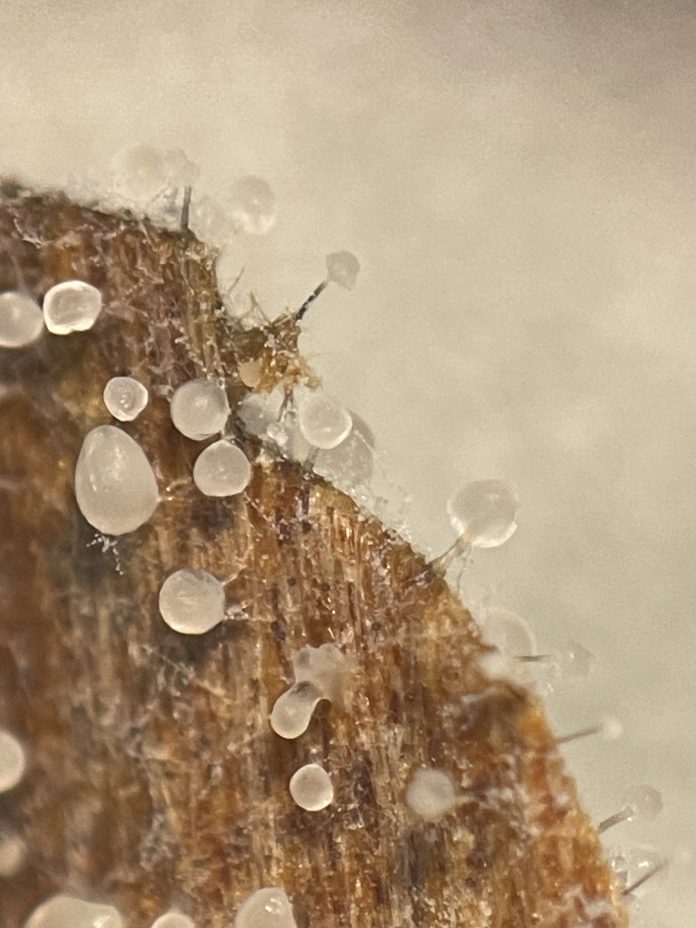
Jill Thomson
Dutch Elm Disease (DED) is probably one of the best-known tree diseases in any country where elm trees grow. It was originally identified in Holland, in 1921, by a Dutch plant pathologist. Since then, the disease has spread throughout Europe, parts of Asia, and most of the areas in North America where elms grow naturally. It was first found in Ohio and eastern coast states in the early 1930’s and in eastern Canada in 1944.
It is a very complex disease, caused by two fungal species, Ophiostoma ulmi and Ophiostoma novo-ulmi, that have two spore stages that occur in the elm tree. One of these spore stages is responsible for the physical deterioration of the tree, and hence the symptoms of the disease. The other spore stage is involved in the transmission of the fungus from tree to tree. Three species of bark beetle (native elm bark beetle, European elm bark beetle and banded elm bark beetle) are responsible for the movement of these spores. The insects choose to lay their eggs in dead or dying elm wood, which typically has spores inside the woody tissues. When the insects’ eggs hatch they eventually produce the adult stage that leaves the infected wood, covered in spores, which are then “injected” into healthy trees by feeding adult beetles.
As a plant pathologist I am curious as to how this relationship came about. Were sick trees more attractive to beetles because it was easier to bore in and lay eggs? Why does the fungus produce 2 types of spores? Is one spore more readily transported by the emerging beetles? Lots of questions can be posed, and really the answers (if we ever find them) are irrelevant now, as the host/pathogen relationship is currently a very effective system for causing and spreading disease.
Different methods of control have been used in different regions. The most cost effective methods currently being used are prompt removal and destruction of trees with any signs of infection, pruning and removal of dead wood that would provide egg-laying sites for beetles, and prevention of distribution of infected material. The city of Saskatoon, and the government of Saskatchewan have developed pamphlets outlining these preventative measures. Help lines are listed to assist the public in identifying and preventing spread of DED. Some of these guidelines are even displayed on road signs (“Do NOT transport elm wood” around the province). About 20 years ago fungicidal treatments of specific trees were carried out but this was expensive and only used on very “important “trees. Chemical control of the bark beetles that are responsible for transmission of the fungus has also been tested.
Another method for reducing the impact of DED is to plant less susceptible trees in cities. The elm has been widely used as a shade tree in the majority of Canadian towns and cities, and several replacement species have different problems that become more obvious when planted on city streets. For example, in Saskatoon the cottony psyllid has been a more noticeable insect pest since ash trees were planted more frequently. Similarly black knot fungus infections are very obvious on the Mayday trees planted in the city. Some species of elm are less susceptible to DED; for example, Siberian elm is moderately tolerant to the disease unless it is weakened by other stresses, environmental or pest pressure. There are also breeding programs in progress that are trying to increase the resistance to disease in certain types of elms.
Identification of DED can be difficult as there are other pathogens that cause wilting, plus environmental conditions that can cause similar symptoms. The Saskatchewan Crop Protection Lab (CPL) in Regina, tests samples of elm wood for the presence of DED, using a method involving isolating and culturing the fungus present in the wood. This ensures that a correct diagnosis is made. In 2023, 481 samples were submitted to the CPL, almost 200 more samples than in 2022. Of these samples, 193 tested positive for DED, 266 were negative , and 22 were found to have wilt caused by a different fungus – Dothiorella sp. The majority of these samples came from the cities of Saskatoon, Regina, and Moose Jaw, but the disease also occurs in parks, particularly among the elms growing beside the rivers. A map produced by the government of Saskatchewan shows the known extent of DED in 2023, and the area goes from Cumberland House in the north to Assiniboia in the south, Melfort, Outlook and Moose Jaw in the west to the Manitoba border in the east. These areas all contain river systems with stands of native elms.
In the past few years very precise laboratory tests have been developed to identify what fungus is present in diseased tissue, using biochemical analysis of the genetic code present in the fungal sample. This is helpful in discriminating between wilt caused by Ophiostoma species and Native elm wilt caused by Dothiorella sp. DED can cause death of trees very quickly (few months to a year), while the Native wilt usually progresses more slowly although it is eventually fatal. Removal and destruction of these infected trees is also recommended.
Whatever pathogen causes wilting and death of our elms, it is imperative that the public is vigilant in spotting possible disease, and that guidelines for pruning trees, disposing of infected wood, and not transporting elm wood are followed precisely.
Jill Thomson is a retired plant pathologist. She thanks James Bush ( Manager of the CPL) for information provided for this article.
This column is provided courtesy of the Saskatchewan Perennial Society (SPS; saskperennial@hotmail.com). Check our website (www.saskperennial.ca) or Facebook page (www.facebook.com/saskperennial) for a list of upcoming gardening events.
